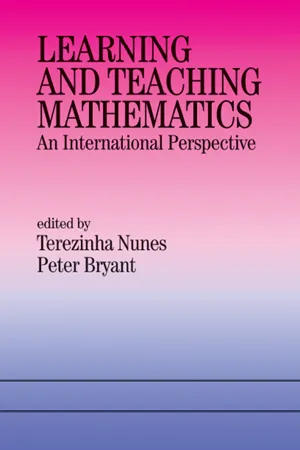Mathematics
Algebraic Notation
Algebraic notation is a system for representing mathematical expressions and equations using symbols and letters. It is commonly used in algebra to express relationships and operations in a concise and standardized way. In algebraic notation, variables are often used to represent unknown quantities, and operations are denoted by specific symbols such as +, -, *, and /.
Written by Perlego with AI-assistance
Related key terms
5 Key excerpts on "Algebraic Notation"
- eBook - ePub
Learning and Teaching Mathematics
An International Perspective
- Peter Bryant, Terezinha Nunes(Authors)
- 2016(Publication Date)
- Psychology Press(Publisher)
The different interpretations will lead to different ways of tackling the problem and to different solutions: in the former case one finds the roots of the equation using the quadratic formula, in the latter the values of parameters p and q are sought for which the coefficients of the same powers of x in both expressions are equal (p + 2 q = 5 and 3 p - q = 1). From this first section of the chapter, one might be led to conclude that there could be as many different perspectives on algebra as there are researchers one might choose to listen to. However, underlying all these perspectives—even a functional one—one can find a few common threads. All use algebra at least as a notation, a tool whereby we not only represent numbers and quantities with literal symbols but also calculate with these symbols. One could stretch this definition to the extent of saying that algebra is also a tool for calculus (in fact, historically, algebra led to calculus). However, that would miss the point, which is that the symbols have different interpretations depending on the conceptual domain (i.e. the letters represent different objects in school algebra than they represent in the calculus courses). In addition, some new symbols are generated and the procedures for calculating with the symbols also change in subtle ways as one moves from one mathematical sub-discipline to another. Algebra can thus be viewed as the mathematics course in which students are introduced to the principal ways in which letters are used to represent numbers and numerical relationships—in expressions of generality and as unknowns—and to the corresponding activities involved with these uses of letters—on the one hand, justifying, proving, and predicting, and, on the other hand, solving. These uses of algebraic letters all require some translation from one representation to another; furthermore, the activities associated with these letter-uses all require some symbol manipulation - eBook - ePub
- Britannica Educational Publishing, William Hosch(Authors)
- 2010(Publication Date)
- Britannica Educational Publishing(Publisher)
LGEBRAIC TERMS AND CONCEPTSA n alphabetic compendium of terms and concepts commonly encountered in algebra is provided in this chapter.ALGEBRAIC EQUATION
An algebraic equation is a statement of the equality of two expressions formulated by applying to a set of variables the algebraic operations, namely, addition, subtraction, multiplication, division, raising to a power, and extraction of a root. Examples are x 3 + 1 and (y 4 x 2 + 2 x y – y )/(x – 1) = 12. One important special case of such equations is that of polynomial equations, expressions of the form a x n + b xn -1+ … + g x + h = k . They have as many solutions as their degree (n ), and the search for their solutions stimulated much of the development of classical and modern algebra. Equations like x sin (x ) = c that involve nonalgebraic operations, such as logarithms or trigonometric functions, are said to be transcendental.The solution of an algebraic equation is the process of finding a number or set of numbers that, if substituted for the variables in the equation, reduce it to an identity. Such a number is called a root of the equation.ALGEBRAIC NUMBER
An algebraic number is any real number for which there exists a polynomial equation with integer coefficients such that the given real number is a solution. Algebraic numbers include all of the natural numbers, all rational numbers, some irrational numbers, and complex numbers of the form pi + q , where p and q are rational, and i is the square root of −1. For example, i is a root of the polynomial x 2 - eBook - ePub
- Lawrence A. Trivieri(Author)
- 2011(Publication Date)
- Collins Reference(Publisher)
CHAPTER 11An Introduction to Algebra
I n this chapter, we introduce algebra as a generalization of arithmetic. In algebra, we use letters to represent numbers. Algebraic expressions are discussed, including evaluating and combining them. Removing symbols of grouping is also discussed. In addition, the language of algebra is introduced. Linear equations in a single variable is also discussed, together with the applied problems they can help solve.11.1 EVALUATING ALGEBRAIC EXPRESSIONS In this section, you learn to classify algebraic expressions as sums or products and to evaluate an algebraic expression. ALGEBRAIC EXPRESSIONSIn algebra, letters are used to represent numbers. Such letters are called variables. The numbers are called constants. For example, in the expression × + 3y, the constant is 3; the variables are x and y . An algebraic expression is an expression that consists of constants and variables. Operation symbols and grouping symbols may also be included in the expression.The following are algebraic expressions:- x + y 2 + z3
- –2a +3bc
- 5m 3 – 3q5
- –7xyz
- u 3 –8u + u +
For our purposes, a difference is treated as an algebraic sum. Hence, x – y means x + (–y ). The expression 3u – 2v is called a sum of two terms, which are 3u and – 2v .- The algebraic expression 4t 2 – 3t can be written as 4t 2 + (–3t ). The constants are 4, 2, and –3; the variable is t
- The algebraic expression 3s 4 – 2s – 3 + can be written as 3s 4 + (–2s ) + (–3)
- The constants are 3, –2, and – 3; the variable is s .
In an algebraic expression, a term is part of a sum. Terms are separated by + or – signs. A factor is part of a product.Exercise 11.1Determine whether each of the following expressions is a sum or a product. If a sum, determine the number of terms; if a product, determine the number of factors. - Marcia L. Tate(Author)
- 2019(Publication Date)
- Corwin(Publisher)
5 25 Sample Mathematics LessonsAlgebra Grades 9–12 Lesson 1
Algebraic Symbols
Lesson Objective(s): What do you want students to know and be able to do?Represent words and phrases using algebraic symbols.Assessment (Traditional/Authentic): How will you know students have mastered essential learning?Assess the handout What’s That? found in this plan.Ways to Gain/Maintain Attention (Primacy): How will you gain and maintain students’ attention? Consider need, novelty , meaning, or emotion .Have students write a shopping list while you call out the items to them. Name the items quickly enough so that the students have time to write down abbreviations for them but not the entire words.Point out that they probably used abbreviations or symbols to represent the words on the shopping list. Today they will learn how algebra can represent words and phrases by using variables, constants, and operation symbols.Content Chunks: How will you divide and teach the content to engage students’ brains?Lesson Segment 1: Translate Between Words and Algebraic Terms
• Activity 1: Algebraic Terms
Tell students the following:- A variable is a letter or symbol used to represent a value that can change.
- A constant is a value that does not change.
- A numerical expression may contain only constants and/or operations.
- An algebraic expression may contain variables, constants, and/or operations.
Have students remember that 2 + □ = 7 and- eBook - ePub
The Learning and Teaching of Algebra
Ideas, Insights and Activities
- Abraham Arcavi, Paul Drijvers, Kaye Stacey(Authors)
- 2016(Publication Date)
- Routledge(Publisher)
The feel for symbols and the confidence in them that guide the search for new aspects of the original meanings are part of what Arcavi (1994, 2005) calls symbol sense. Arcavi (1994) gives many more examples of symbol sense and its value for mathematical work. One important feature is looking carefully at symbols rather than jumping immediately to automatic procedures. In the next section, the power of algebra for solving very wide classes of problems in almost completely routine ways is highlighted. However, algebra with symbol sense is much more than a routine of symbol pushing.In summary, Algebraic Notation captures and displays mathematical structure. Students’ experiences in learning arithmetic only rarely foster an appreciation of structure. This is another of the many obstacles which students have to negotiate in order to make the transition from arithmetic to algebra. Algebra spectacles enable students to seek structure and to read the meaning of the structure expressed in the symbols.3.6 Transitions From Learning Arithmetic to Learning Algebra 3.6.1 Contrasting Arithmetic and Algebraic Problem SolvingSingapore schools are renowned for their high achievement in mathematics. The curriculum is based around problem solving so there are some difficult problems in the highly competitive Primary School Leaving Examination (PSLE). This is undertaken by Grade 6 students and largely determines which secondary school they attend. Since formal algebra is not part of the curriculum until secondary school, students are expected to solve these problems arithmetically. Surprisingly, some tutors teach their students algebra so that they can solve some of the PSLE problems more easily. How can it be that tutors might think learning algebra is the easiest path? The answer to this puzzle lies in the contrast between the power of solving problems in arithmetic and algebra, the methods used and consequently the obstacles that students encounter. Figure 3.4
Learn about this page
Index pages curate the most relevant extracts from our library of academic textbooks. They’ve been created using an in-house natural language model (NLM), each adding context and meaning to key research topics.




